

www.combatreform.org/Gnat-GJ-Brochure.pdf
The Mighty Gnat
Indo-Pak Wars Immortalize the Greatest Little Fighter Aeroplane
by Air Vice Marshal Milind Shankar
A "Gnat", the dictionary tells us, is a small two-winged insect which can bite or sting.
What an appropriate name for the world's smallest operational jet fighter aircraft!
The lightweight fighter concept was the brainchild of renowned British designer Mr. WEW Petter. Amongst the aircraft Petter had designed were the Lysander (which flew with the RIAF and an example of which is in the Air Force Museum at Palam) and the English Electric Canberra. Later, it was at English Electric, while designing the P.1 fighter (named Lightning), that Petter began to have misgivings about the weight and size of the new fighter. With weight and size came expense, and Petter increasingly believed that lightweight and low-cost designs were the way forward.
Unable to pursue this vision at English Electric, he left in 1950 to become Managing Director of Folland Aircraft Company in the town of Hamble. In 1951, using company funds, he began work on his lightweight fighter. The forerunner of the Gnat, designated "Midge", flew in August 1954 from Boscombe Down with Folland test pilot E.A. "Teddy" Tennant at the controls. Further test flying was done from Chilbolton, Supermarine Aviation Works' airfield, since flight testing could not be done at Hamble. The Midge was an excellent aircraft, highly manoeuvrable and supersonic in a dive. In September 1954 it was flown for the first time at the Farnborough Air Show.
The Midge came to the attention of the IAF quite by chance. In October 1954 an IAF evaluation team comprising Air Commodore PC Lal (later CAS), Group Captain H. Moolgavkar (later CAS) and test pilots Squadron Leaders R.L. Suri and S. Das had been sent to France and UK to fly the Mystere and the Supermarine Swift. After testing the Mystere they moved to UK to evaluate the Swift. While flying the Swift, Air Commodore Lal noticed a tiny fighter aircraft flying close to Chilbolten. It was the Midge. The IAF team decided to evaluate the Midge too, which was duly done the following month. Impressed with the handling qualities of the little fighter, the team recommended that the Midge be considered for induction into the IAF.
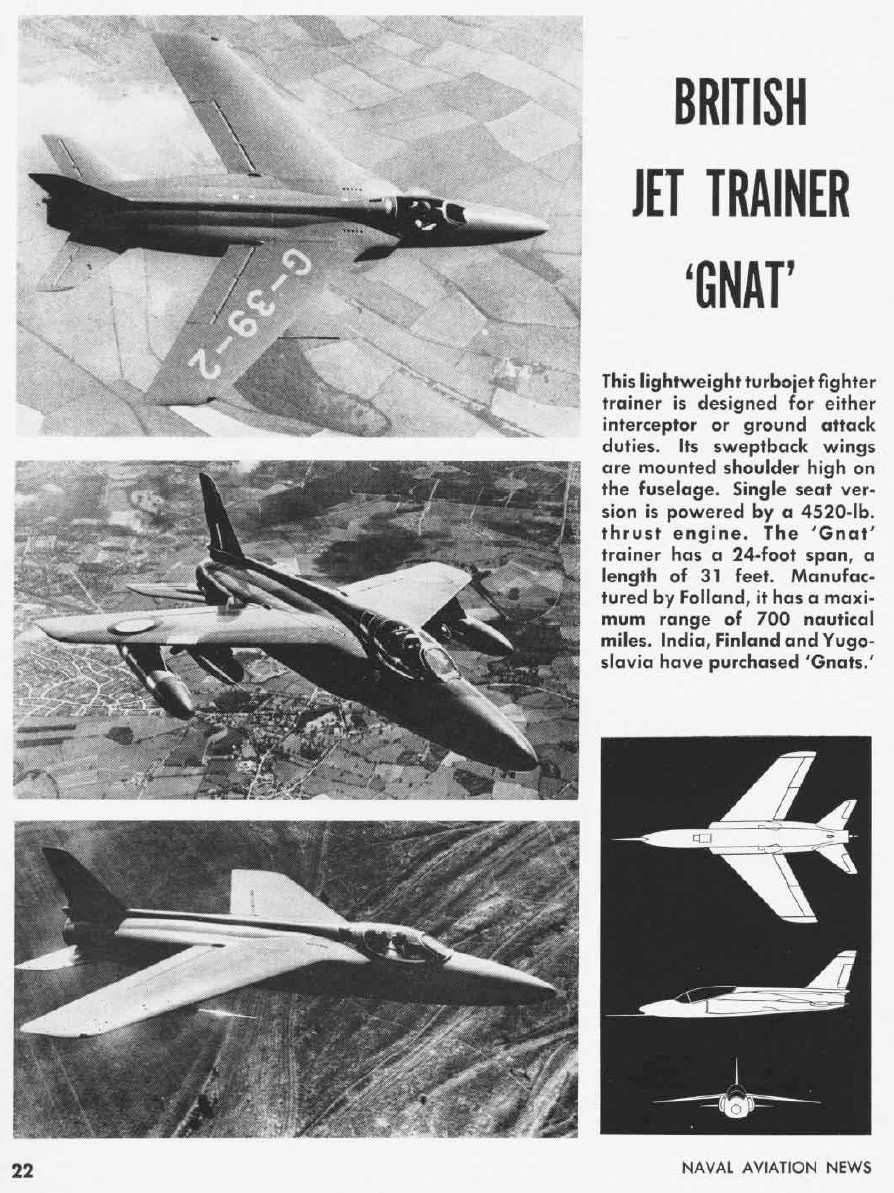
The inventor of the Gnat was alarmed at the increasing size and complexity of fighters while working on the twin-engined Lightning interceptor, left the company to work for the start-up Folland where he designed the Midge which gained the interest of the Indian Air Force and developed in the legendary Gnat.

What's very interesting is that the IAF got their first Gnat by removing its wings and flying it inside a C-119 transport plane! This implies its not that hard to remove its wings for FINAB applications, though wing folding would be faster. Another point is the Gnat in IAF service never got air-to-air missiles (AAMs) like the Sidewinder; its highly likely that a Gnat would be able to bounce enemy fighters while not itself being seen and shoot off AAMs and destroy them from extreme visual ranges and not have to line-up for gun kills. If fitted with a beyond-visual range (BVR) AAM like the AIM-120 AMRAAM perhaps with a radar-seeking guidance head, the Gnat looks very close to what Sprey is calling for in his Swarm Fighter concept: a fighter that can kill the enemy fighters without having to turn on (or carry) a radar. The "Super Gnat" could easily be launched from mobile BATTLEBOX containers using a transporter erector launcher (TEL) unit using ZEL rockets or from a short runway using JATO rockets. Super Gnats could even be air-launched from a SkyCrane-type heavy-lift helicopter to avoid detection/destruction on runway air bases.
www.combatreform.org/supergnat.htm
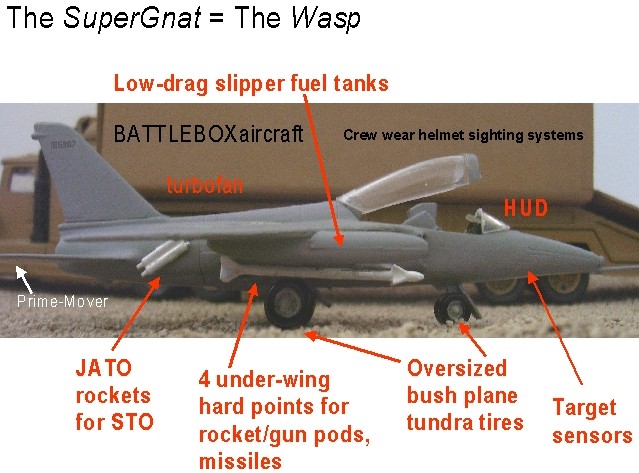
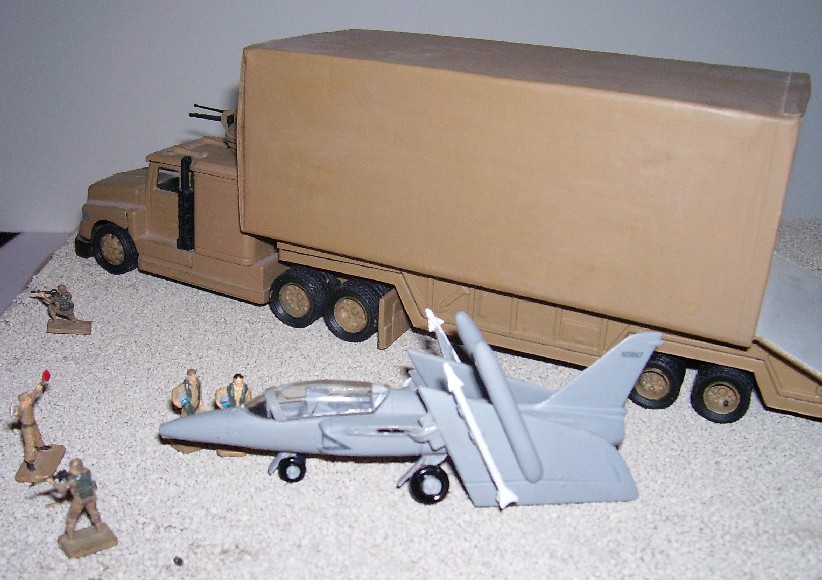
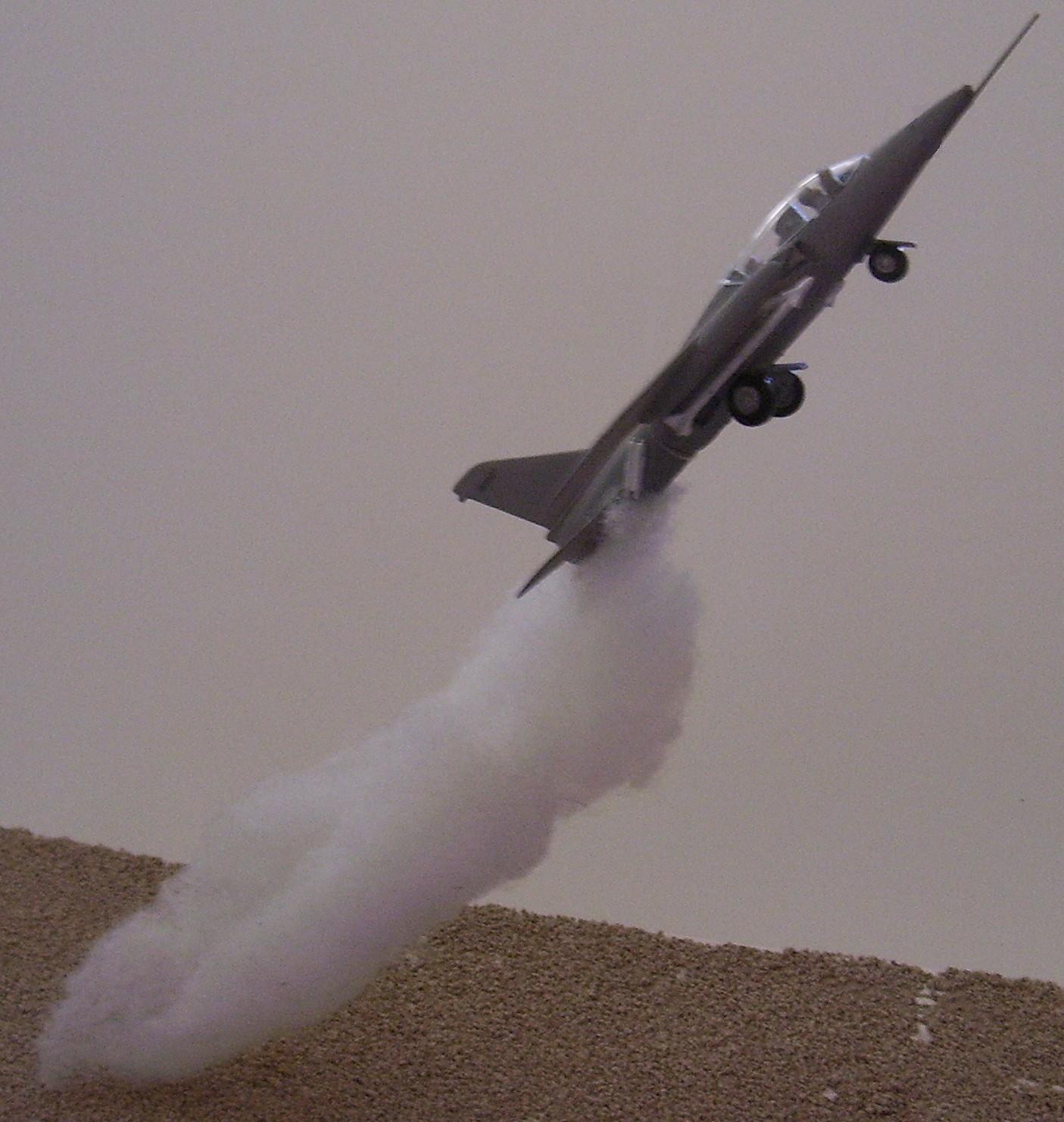



Serving mostly with
Indian Air Force, the Gnat is credited by many independent and Indian sources to have shot down seven Pakistani F-86 Sabres in the 1965 war[1][2][3][4]. Pakistan Air Force (PAF) however, disputes this claim and only accepts the downing of 3 F-86s at the hands of the Gnat in Air to air combat[1]. In return two Gnats were downed by PAF fighters. During the initial days of the 1965 War an IAF Gnat, piloted by Squadron Leader Brij Pal Singh Sikand, landed at an abandoned Pakistani airstrip at Pasrur and was captured by the PAF. Pakistanis initially claimed that the Gnat surrendered to two Pakistani F-104 Starfighters after straying from its main formation [5], while the Indians claimed the pilot lost his way and landed by mistake [2]. Later, a retired PAF historian, Air Cmde Kaiser Tufail, mentioned that the Gnat actually landed before the F-104 arrived on the scene, giving credibility to the Indian version[3]. This particular Gnat is displayed as a war trophy in the Pakistan Air Force Museum, Karachi. After the cease-fire, one Pakistani Cessna O-1 [Bird Dog] was shot down on 16 December, 1965 by a Gnat.[4]Bangladesh Liberation War

Gun camera stills released by the
Indian Air Force show FLTLT M.A. Ganapathy's Gnat scoring hits on FLGOFF Khalil Ahmed's F-86 Sabre over Boyra during the Battle of Boyra in the 1971 Indo-Pak warThe Gnats were used again by India in the
Bangladesh Liberation War against Pakistan with good results.[6][7] The most notable battle was the Battle of Boyra which witnessed the first dogfighting over East Pakistan during the war. The IAF Gnats played a vital role in this battle and claim to have downed two PAF Sabres in minutes and badly damaged one. The Pakistan Air Force accepts the loss of 2 F-86s and claims that 1 Gnat was shot down in this particular battle. Incidentally, this Gnat Squadron that inflicted the damage was commanded by Brij Pal Singh Sikand who was taken as POW in the 65 war. Another notable dogfight involving a Gnat was the one over Srinagar airfield where a lone Indian pilot flying a Gnat held out against 6 Sabres[8], scoring hits on two Sabres[9][10] in the process before being outnumbered. The Gnat pilot, Nirmal Jit Singh Sekhon, was posthumously honoured with Param Vir Chakra (India's highest gallantry award) becoming the only IAF personnel to be given the award.
gnatcockpitcutaway.jpg
By the end of 1971, the Gnat had lived upto its nickname of Sabre Slayers in the
Indian Air Force and interestingly, all its combat "kills" during the two wars were against the Sabres. The Gnat proved to be a frustrating opponent for the technically superior Sabres[11][12] - especially since the Sabre Mk VI, was widely regarded as the best "dog-fighter" of its era[13] - in both the wars and earned the nickname "Sabre killers" by the IAF[5][6]. Tactics called for Gnats taking on the Sabres in the vertical where they had a chance and came out trumps. Moreover, because it was lightweight and compact in shape, it was hard to see, especially at low levels where most of the dogfights took place.[4] Apart from air defence operations, the aircraft perfomed multiple roles in the Bangladesh Liberation War being utilized in Anti-Shipping Operations, Ground attack, Bomber/Transport escort and Close Air Support with "devastating effects" on the PAF.[6] According to RAF Museum reports, Gnats proved more than a match for their opponents in air combat.[7] The success of the indigenously produced Gnats against the more sophisticated Pakistani-flown planes was viewed by one military writer as a significant achievement.[14]The
IAF were impressed by its performance in the two wars, but the plane had problems like hydraulics and some of its control systems were unreliable. To address these issues, the IAF issued a requirement for an improved "Gnat II" in 1972, at first specifying that the new version was to be optimized as an interceptor, but then expanding the specification to include the ground-attack role. The HAL-built licensed version was called the Ajeet (Unconquerable). Many of the Indian Gnats were built in Bangalore with over 175 made there along with about 40 purchased direct from Folland. Gnats served in India from 1958-1978, and several remain in use in private hands. Some IAF Gnats, one of which had participated in the 71 war in East Pakistan (present day Bangladesh) were presented to the Bangladesh Air Force by India.[7]
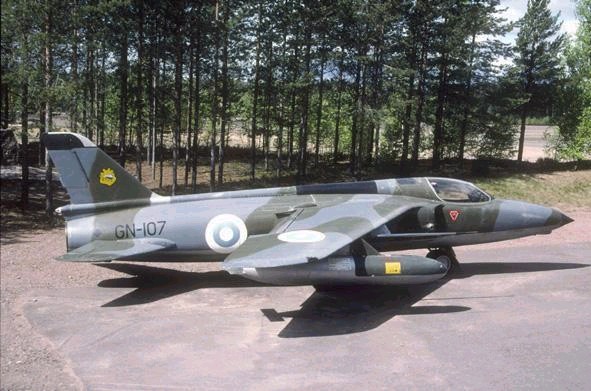
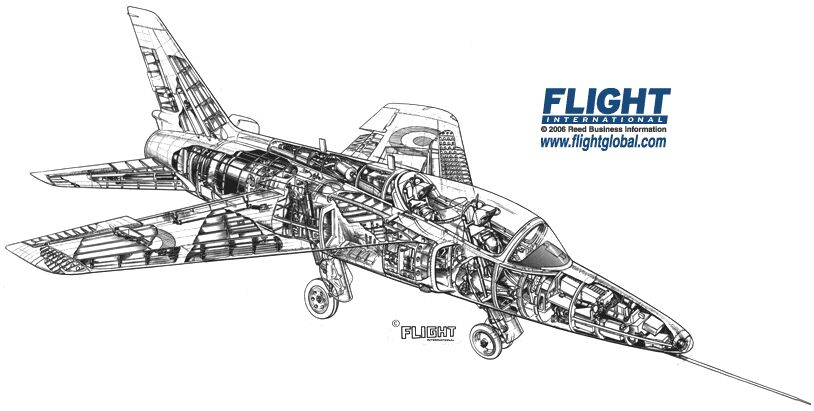
In Britain it served as the Folland Fo.144 Gnat Trainer (later renamed the Gnat T.Mk 1), most notably as the demonstration aircraft of the
RAF's Red Arrows aerobatic team. A few served with Finland. Finland too was another user, but had stopped using Gnats by 1974, and the UK by 1979.
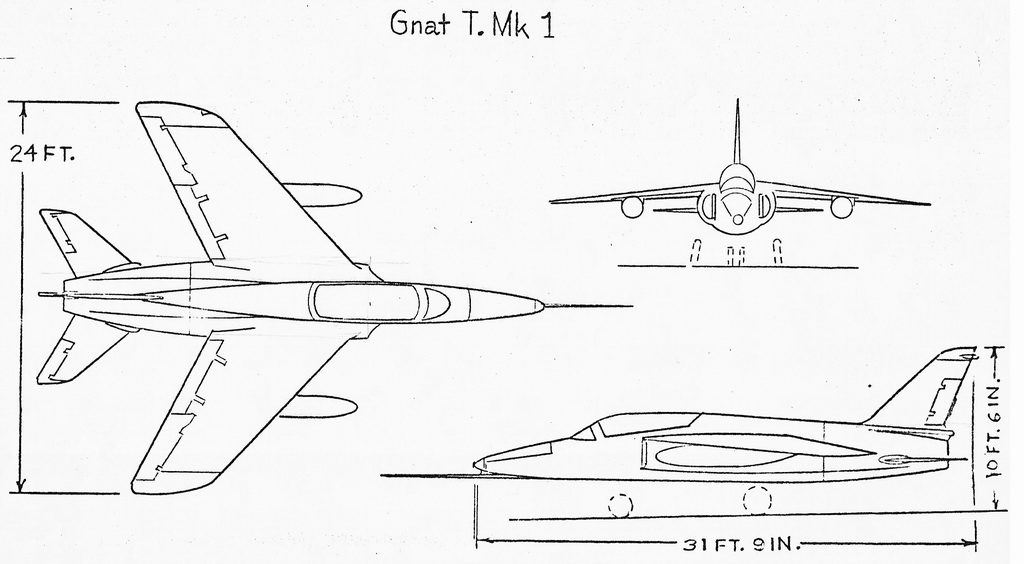
The Gnat's experimental precursor was the
Folland Midge, which used a less-powerful engine.When the RAF replaced and sold-off its Gnat T.Mk 1 trainers many were bought by private collectors and subsequently appeared (along with some single-seat Gnats) in the
Charlie Sheen movie Hot Shots.One of the few remaining Gnats in the UK is currently being restored to flight status at
Bournemouth Airport, in Southern England. Once restored, XR537 (or G-NATY as she is registered on the civilian register) will be the only genuine former Red Arrows Gnat on the European display circuit. She can be viewed at Bournemouth Aviation Museum. Like many ex-military jet aircraft, there is one (G-FRCE) based at North Weald Airfield in Essex [8]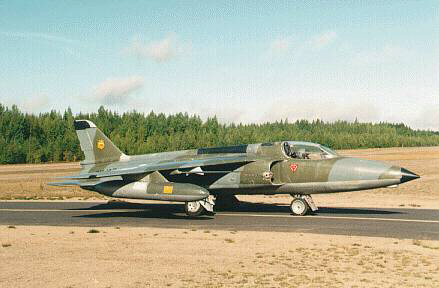

On the left is the single-seater fighter version of the Gnat. The Gnat trainer on the right was a two-seater aircraft with other modifications.


Proposed Twin-Engined Gnat Fighter-Bomber
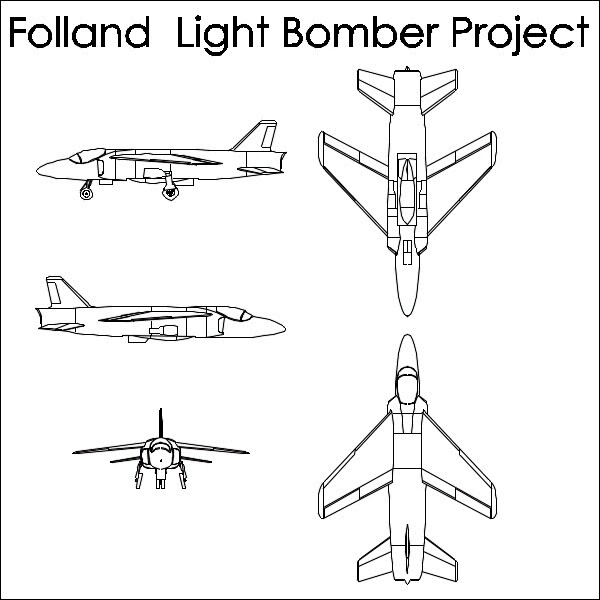
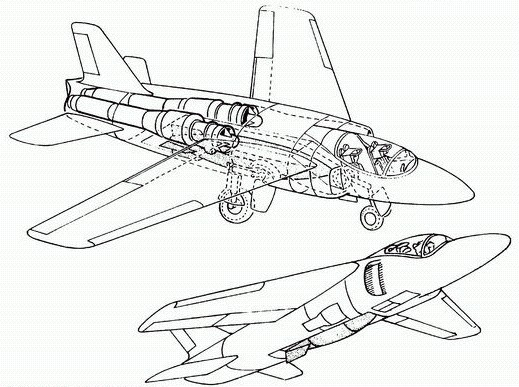
Data from
The great book of fighters[15]
The Rediff Special/
Samir Chopra and PVS Jagan Mohan
The Wolfpack in action
October 26, 2005
In this second extract from
The India Pakistan Air War of 1965, we look at how 4 Gnats got into a dogfight with the superior Pakistani Sabres, and won.Part I: On a wing and a prayer
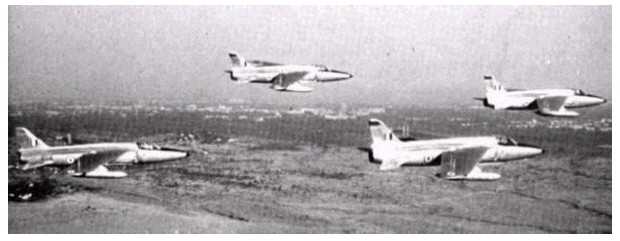
S
eptember 19, 1965: That afternoon, a flight of four Mysteres of 1 Squadron was detailed to carry out an offensive sortie in the Chawinda-Pasrur Sector.http://in.rediff.com/news/indpakwar05.htm
9 (Wolf Packs) Squadron was given the task of providing escort to the 4 Mysteres. The Gnats consisted of two sections. The first was led by Squadron Leader Denzil Keelor with Flying Officer 'Munna' Rai as his wingman. Flight Lieutenant Viney `Kaddu' Kapila - with Flight Lieutenant Vijay Mayadev as No.4 - led the second section.
The Mystere and Gnat formation made its way to the target area at Chawinda at low-level and were greeted with anti-aircraft fire. Kapila spotted a formation of 4 Sabres ahead and above at 2000 feet and called out his sighting on the R/T to Keelor and JP Singh.
Singh decided to make a single pass over the target area and exit quickly without hanging around for a second pass. About this time, Mayadev, the No.4 in the formation, also called out a warning on the R/T about the 4 Sabres. Keelor put the formation in a shallow climbing turn to bring the Gnats in a favourable position.
The 4 Sabres - from Sargodha's 17 PAF Squadron - were being led by their CO, Squadron Leader Azim Daudpota. Neither Daudpota nor his wingmen noticed the 4 Gnats led by Keelor come in at low-level behind them. As Keelor began maneuvering the Gnats behind the Sabres, they were noticed and a quick call put the Sabres into a defensive break. The Gnats split up in two sections. Keelor and Rai went after one pair of Sabres, and Kapila and Mayadev after the other.
When Keelor followed the first pair of Sabres in a tight turn, Rai lost visual contact with both Keelor and the Sabres.
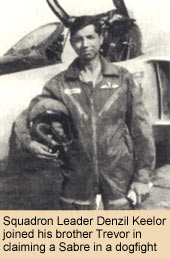
Keelor instructed Rai on the R/T to set course for Adampur and to get out of the fight, which Rai complied with immediately. This left Keelor tangling with the first section of two Sabres.
Meanwhile Kapila and Mayadev got behind the second section of the Sabres, who then reversed their turn and broke into the attackers. By the time the Gnats recovered from this maneuver Kapila found himself at a very low altitude, less than 100 feet from the ground and flying at treetop height. However he still had one of the Sabres in his gyro sight.
The Sabre tried to shake off Kapila by first engaging into a steep turn starboard and then again in the opposite direction to port. Kapila had by this time jettisoned his drop tanks, which gave him a slight edge in maneuverability. He accelerated and opened fired with his cannon at 500 yards, scoring direct hits on the Sabre.
The Gnats had met the Sabres at an altitude of 1, 500 feet, and now the Sabre - damaged by Kapila's first burst - fell back. Kapila fired a second burst from 300 yards and again the cannon shells tore into the Sabre. Its pilot though, still executed turns and breaks to shake off Kapila who in quick succession let off two more bursts. As he finished the third burst, scoring more hits on the Sabre, he noticed the Sabre begin to roll over.
Kapila broke off the attack and hauled his Gnat vertically upward as he heard Keelor's call on the R/T, "Kaps you hit him!". Kapila banked his aircraft and saw the Sabre hit the ground, but neither he nor Keelor saw the pilot ejecting.
Keelor, meanwhile, was not only keeping an eye on his 2 adversary Sabres but also on Kapila's section, giving them periodic 'tail clear' messages. He missed seeing the No.4 Sabre from the PAF formation - flown by Flying Officer Saif-Ul Azam - sneak in behind Kapila's section and get on Mayadev's tail. Mayadev's tail and elevator surfaces were riddled with .50 caliber bullets by Azam's gunfire. Mayadev ejected barely 500 feet above the ground from his stricken Gnat.
Having lost contact with Mayadev's Gnat, Kapila looked around to spot Keelor's Gnat and turned around to join him. By that time Keelor had observed another Sabre break out of the melee and head for safety. He put his Gnat into pursuit.
The Sabre failed to notice the Gnat and did a hard turn to the right, which bought it within range of Keelor's guns. The Sabre was hit and started streaming smoke and losing altitude. Keelor pulled out of the attack as his closing speed was high and he had lost enough altitude to be skimming the treetops.
As the Sabre started moving away, Kapila came in to deliver the coup-de-grace with a well-aimed cannon burst. However once again, Kapila's guns jammed after the initial burst and he had to pull out of the attack. His gun camera film clearly showed Keelor's smoking target in his sights.
Subsequent analysis on gun camera film and combat reports at Halwara and Adampur resulted in both Keelor and Kapila being awarded air combat kills and the Vir Chakra at the end of the war.
The Sabre kill by Denzil earned the Keelor family a unique distinction. Both the brothers now had Sabres to their credit and both earned the Vir Chakra, making it the first time brothers had won the Vir Chakra for identical feats.
Extract and picture from
The India Pakistan Air War of 1965, PVS Jagan Mohan and Samir Chopra.
The Swift fall in the category of types of birds of prey, which rely on high speed for interception in the open. Swifts have slim wings like a modern fighter aircraft, designed for high speed and maneuverability. A Swift is a long winged, insectivorous bird, stalking and attacking its prey for food with speed, surprise and agility. The largest species of the bird have wing span of 2 feet, a top flying speed of 160 KMPH and can fly a total of 600 miles a day even when feeding its Swift-let. The Swift is extremely fast and has a keen sense of sight, which enables it to spot and intercept its prey from great distance with extreme accuracy.
A fighter aircraft like the AJEET, operating in the skies, is in perfect harmony with the Swift. The AJEET has the same ability to cruise, maneuver, and surprise the enemy with speed and ferocity in attack. As the symbol of 22 Squadron, AF operating AJEET aircraft, the Swift is just appropriate.
During Operations in December 1971, after 3 intruding Sabre were shot down by the Squadron Pilots, the Squadron earned its name as "SABRE SLAYERS". On 20 December 1985, the President of India awarded the present crest of the named 'SWIFT'. Swift is a small bird, found in the sub-Himalayan tropical forests, famous for its speed, agility and offensive nature. The suitable motto for the Swifts, therefore, was decided as 'COURAGE TRIUMPHS'.
22 Squadron, AF, known as the 'SWIFTS' was formed on 15 October 1966 at AF Station Bareilly under Central Air Command. The unit was then equipped with the Gnat Mk-I aircraft. In March 1982, the Squadron was re-equipped with Ajeet Mk-I aircraft. During that period, the Squadron was assigned Ground Attack and Air Defence roles. With the re-equipment of the unit with the HAL built MiG-27 ML aircraft in April 1990, the Squadron was tasked solely with a Ground Attack role.
After its initial formation at AF Station Bareilly, the unit moved to Kalaikunda under Eastern Air Command in September 1968. Since then, the unit has moved in EAC at different bases and has been located at AF Station Hasimara since 5 February 1990.
When hostilities broke out in 1971, during the Indo-Pakistan conflict, the Squadron was only five years old. It was then operating from 5 Wing, AF. The Squadron operated from Dum Dum from 22 September to 26 September 1971 to familiarise with the area. During hostilities, the Squadron operated from Dum Dum from 3 December to 26 December 1971. It was the first Gnat Squadron in the Eastern sector to go into the battle with PAF. It did so with such devastating effects that the PAF treated the diminutive Gnat with respect and caution thereafter. During the operations, the task allotted to the Squadron was five folds: